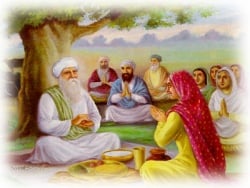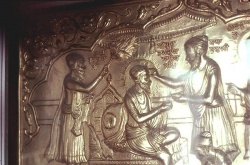Baba Buddha
Baba Buddha ji (6 October 1506 - 8 September 1631), one of the most venerated, primal figures of early Sikhism, was born on 6 October 1506 at the village of Katthu Nangal, 18 km northeast of Amritsar.
After sometime the family settled down in Dhalla village not far away from river Ravi opposite Kartarpur. "Bura", as he was originally named, was the only son of Bhai Suggha, a Hindu Jatt of Randhawa clan, and Mai Gauran, who was born into a Sandhu family.
Also referred to reverently as Baba Buddha Ji; Bhai Buddha occupies a unique position in Sikh history and in the hearts of all Sikhs. He applied the tilak of guruship to five Gurus, saw and had the vision of seven Gurus and remained in close association with the first six Sikh Gurus from 1521 to 1631 for over one hundred years.
He was the first "priest" (or Giani) of Harimandir Sahib, and laid the foundations of Dera Baba Nanak and most of the holy buildings at Amritsar. It was the greatness of Guru Nanak that the seva (service or task) of applying tilak was given to Baba Buddha ji, given the fact that he belonged to a so-called low caste.
Background

image courtesy:www.sikhs.nl
One day, when he was young, he was grazing cattle outside the village when Guru Nanak happened to pass by. According to Bhai Mani Singh's, Sikhan di Bhagat Mala (The Holy Sikh Jewels), Bura went up to him and, making obeisance with a bowl of milk as his offering, prayed to him saying:
- "O sustainer of the poor! I am fortunate to have had a sight of you today. Absolve me now from the circuit of birth and death."
The Guru said, You are only a young man, yet you talk very wisely." Then he related a story to Guru Nanak, "Some soldiers set up camp by our village and then they mowed down all of our crops, the ripe ones and the unripe ones, as well. Then it occurred to me that, when no one could check these indiscriminating soldiers, who would restrain death from laying his hand upon us, young or old."
At this Guru Nanak pronounced the words: "You are not a child; you possess the wisdom of an old man." From that day, Bura, came to be known as Bhai Buddha, buddha in Punjabi means wise (wisdom usually only comes with age). Later, when advanced in years, he was known as Baba Buddha.
Devoted Service to 6 Gurus
Guru Nanak & Guru Angad Dev
Bhai Buddha became a devoted disciple of Guru Nanak. His marriage at the age of seventeen at Achal, near Batala, did not distract him from his chosen path and he spent more time at Kartarpur where Guru Nanak had taken up his abode than at Katthu Nangal.
Such was the eminence he had attained in Sikh piety that, at the time of installation of Bhai Lahina as Guru Angad, (Nanak II), Guru Nanak asked Bhai Buddha to apply the ceremonial tilak on Bhai Lahina's forehead. Bhai Buddha lived to a ripe old age and had the unique honour of anointing all of the four following Gurus. Guru Angad Dev ji invented the Gurmukhi script, the script used in the Guru Granth Sahib.
In order to popularize the new script, the Guru started teaching it to the children of the Sikhs. Bhai Budha also learned Gurmukhi (lit. from the Gurus' mouth) and then took up the Guru's duty to teach it.
Throughout his live Bhai Buddha continued to serve the Gurus with complete dedication, remaining an example of holy living for the growing body of disciples.
Guru Amar Das and Guru Ram Das

He devoted himself with zeal to such tasks as; construction of the Baoli at Goindval under the instruction of Guru Amar Das and the excavation of the Amrit Sarovar (Amritsar) the city that lent its name to Amritsar, under Guru Ram Das and Guru Arjan.
The ben tree under which he would sit, supervising the excavation of the Amritsar pool still stands in the precincts of the Golden Temple. He subsequently retired to a bar (a forest), where he tended the livestock of the Guru Ka Langar. What is left of that forest is known as 'Ber Baba Buddha Sahib'.
The following tuks (lines of Gurbani) can be found in the Guru Granth Sahib that refer to the ascendency to Guruship of the fourth Sikh Guru, Guru Ram Das:
| ਹਰਿ ਭਾਇਆ ਸਤਿਗਰ ਬੋਲਿਆ ਹਰਿ ਮਿਲਿਆ ਪਰਖ ਸਜਾਣ ਜੀਉ ॥ ਰਾਮਦਾਸ ਸੋਢੀ ਤਿਲਕ ਦੀਆ ਗਰ ਸਬਦ ਸਚ ਨੀਸਾਣ ਜੀਉ ॥੫॥ |
| Har bẖĝ▫i▫ĝ saṯgur boli▫ĝ har mili▫ĝ purakẖ sujĝṇ jī▫o. Rĝmḝĝs sodẖī ṯilak ḝī▫ĝ gur sabaḝ sacẖ nīsĝṇ jī▫o. (5) |
| The Lord was pleased as the True Guru spoke; he was blended then with the all-knowing Primal Lord God. The Guru then blessed the Sodhi Ram Das with the ceremonial tilak mark, the insignia of the True Word of the Shabad. (5) |
Guru Arjan Dev & Guru Hargobind
Guru Arjan Dev ji placed his young son, Hargobind, under Bhai Buddha's instruction and training. When the Adi Granth (Guru Granth Sahib) was installed in the Harmandar on 16 August 1604, Bhai Buddha was appointed as the granthi by Guru Arjan. He thus became the first high priest of the sacred shrine, now popularly known as the Golden Temple.
Following the martyrdom of Guru Arjan on 30 May 1606, Guru Hargobind raised, in front of, the Harimandar a platform called the Akal Takhat, the Timeless Throne or the Throne of the Timeless, the construction of which was entrusted to only Baba Buddha and Bhai Gurdas, no one else was allowed to take part in building the platform.
After the Martyrdom of Guru Arjan, the investiture ceremony of Guru Hargobind was held on the new platform that Baba Buddha and Bhai Gurdas had built. Even then, the new platform facing the entrance of the causeway to the Harmandar Sahib was referred to as the Akal Takht Sahib.
Bhai Buddha, as he had done so many times before, was called on again to perform the initiation as he had done before, but on that day (24 June 1606) Guru Hargobind ji took Sikhi in a new direction for he asked Baba Buddha for a sword, rather than the traditional seli that had once been worn by Guru Nanak. Guru Hargobind then put on not one but two swords; one on his left side and the other on his right. He declared that the two swords signified "Miri" and "Piri": "Temporal Power" and "Spiritual Power", one which would smite the oppressor and the other which would protect the innocent.
Last Days
Baba Buddha passed his last days in meditation at Jhanda Ramdas, or simply called Ramdas, a village founded by his son, Bhai Bhana, where the family had since shifted from its native village of Katthu Nangal. As the end came, on 8 September 1631, Guru Hargobind was at his bedside. According to the Gurbilas Chhevin Patshahi, the Guru gave his shoulder to the bier and performed the last rites over Bhai Gurdas, further quoting the Gurbilas, started a reading of the Adi Granth in memory of Baba Buddha.
The obsequies concluded with Bhai Gurdas completing the recital and Guru Hargobind presenting a turban to Bhai Buddha's son, Bhana. Two shrines stand in Ramdas commemorating Baba Buddha, Gurdwara Tap Asthan Baba Buddha Ji, where the family lived on the southern edge of the village, and Gurdwara Samadhan, where he was cremated.
See also
External Links
BIBLIOGRAPHY
- Copyright © Harbans Singh "The encyclopedia of Sikhism.
- gurbilas Chhevin Patshahi. Patiala, 1970
- Bhalla, Sarup Das, Mahima Prakash. Patiala, 1971
- Padam, Piara Singh, and Gianl Garja Singh, eds.,Guru ban Sakhlari Patiala, 1986

